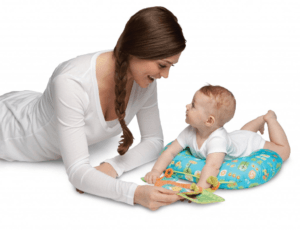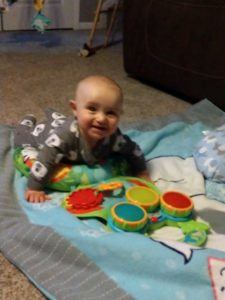Month: February 2018
Why are crawling and creeping important for development?
February 23, 2018 / Diane L. Crecelius, PT, CEO
It is important to remember that each stage of development builds on another. Each step is important for its own reason part of which is to build strength and/or endurance for the next step of development. Preferably you do not want your child to skip any steps as it could affect the ability to master the next step.
Crawling is basically commando crawling. The belly is in contact with the floor, elbows and knees are bent and the head is upright. The child progressively pulls on the floor with bent arms and legs to advance himself across the floor.
Try this – it is hard work!
Your child will develop neck and back extensor strength as well as arm strength that will allow him/her to progress to creeping. Creeping is a means of mobility with the arms straight, belly off the ground and weight on the hands and knees. The child reciprocally moves his/her arms and legs to progress across the floor.
Something you might not consider that is gained with creeping is a different visual field. When a child is commando crawling he/she sees a world that is on the ground. Once creeping, the world a child can view expands. This bring new information into a child’s brain to process and interact with.
A child puts weight on an open hand when crawling. Did you know that this weight on the palm stretches out the small muscles in the hand. This stretching of the muscles prepares a muscle for use for fine motor skills like pinching. Children that do not crawl might have difficulty with handwriting or shoe tying as the strength and endurance to maintain small muscle control to perform these functional tasks might be more challenging.
Interesting fact: Look at your child’s sweet little hand and forearm. Did you know that there are 35 muscles that control the movements of the hand?!?! That is a lot of muscle action!
As you can see, much is gained while crawling and creeping so it is preferable that a child not skip this stage. As a parent do not push your child to walk too quickly. Encourage each stage of development to happen as there is a purpose for each stage that builds upon another.
What should you do if your child skips the creeping phase or does not creep for long? Wheelbarrow walking is a fun activity that will put a lot of weight on the palms and simulate the same muscle actions as creeping. So hold your child’s feet and have them walk with their hands. Make a game out of it. Place puzzle pieces or Mr. Potato Head pieces around the room. Have your child gather the pieces and complete the activity at the end.
Continue to educate yourself as a parent on next step skills in child development so you know what toys to have at home and what skills to encourage and when.
For all your child’s developmental checklists go to https://www.abcpediatrictherapy.com.
Read MoreParenting needs to come with a handbook. How many times have you thought that?
Here is some helpful developmental guidelines so you can become an informed parent. Know what to encourage and when!
By 6 months your child should:
- Sit alone for short periods
- Begin to belly crawl
- Roll back to belly and belly to back

- Grab feet and bring them to mouth
- On belly props up on straight elbows
- Reach for a toy when playing on belly
- Hold a toy and shakes it
- Put fingers in mouth
- Hold hands open at least 1/2 of the time
- Smile at self in mirror
- Cup drinking in introduced
- Soft, smooth solids
- Move chewed food to center of mouth before swallowing
By 9 months your child should:
- Maintain sitting for at least 60 seconds with hands free to play
- Crawl independently
- Pull to stand from floor

- Walk with 2 hands held
- Wave bye-bye
- Release objects intentionally
- Feed self finger foods
- Bang a toy on the floor
- Pass a small object between hands
- Babble same sounds
- Respond to “no”
- Vocalize different syllables
- Tolerate smooth solid foods
- Make sounds while eating with food in mouth
By 12 months your child should:
- Cruise along furniture
- Independent standing
- Get into and out of sitting
- Corral a ball with arms and hands in sitting
- Transition sit to stand and stand to sit
- Grasp thick crayon or pencil in fist, does not mark
- Turn page of a cardboard book
- Help to pull off simple clothing
- Put object into others
- Pull shoes off
- Feed self with fingers
- Babble using different sounds
- Take turns vocalizing
- Point / gesture
- Tolerate coarsely chopped food
If your child is having trouble achieving any of the milestones above, go to https://www.abcpediatrictherapy.com for more information. The ABC staff is here to help you help your child. Each developmental skill builds on the next one. You do not want your child to skip skills or fall behind. Their self confidence depends on it!
Read More
Why is tummy time important?
February 18, 2018 / Diane L Crecelius, PT, CEO
Today parents are offered so many options for positioning for their babies. You can place your baby in a swing, in a bouncy seat, in a stroller, in a car seat, in a Bumbo seat, in a Johnny jump up and in a high chair.
Actually, the best place for your baby when not in your arms is on the floor. This gives your child the opportunity to explore their new world. Place you child on their back under a baby gym so they can reach and play. This will help your baby to discover their hands and improve eye hand coordination.
Now, play on the tummy. This is very important. Why? Let me explain.
 Lying on the belly requires that an infant be able to lift his/her head (this is called extension of the neck) progressing to propping on forearms (more extension now involving the upper half of the back) followed by propping on straight arms (even more extension of the back).
Lying on the belly requires that an infant be able to lift his/her head (this is called extension of the neck) progressing to propping on forearms (more extension now involving the upper half of the back) followed by propping on straight arms (even more extension of the back).
Tummy time gives the child a different visual field to look at and explore.
The strength and endurance required to maintain your position on your belly as well as to weight shift to lift an arm and move is very difficult. Babies often resist this position for an easier position of flexion – lying on their back or snuggling on their parent’s chest.
The head/neck control a baby gains while playing on their tummy allows them to have more success with being held upright as well as gaining the skill of sitting.

Strength in the trunk (the back and belly) helps a child progress to sitting on their own. A balance is needed between the belly, neck and back muscles (flexion and extension) as well as arm strength in order to have success with sitting.
When a child first begins to sit, he/she will prop on straight arms. This arm strength was gained during tummy time propping on first bent then straight arms.
Fun tip: Try this yourself! Lie on your belly and prop on your forearms and then on straight arms. Feel how hard it is to prop on straight arms. Now you can understand why your child might resist this position. Also, you can understand how much strength arms can develop in this position.
Another fun tip: First lie flat on your belly with you arms flat at your sides. Lift your head and look around you. Now prop on your forearms and look around. Finally, prop on extended arms and look around. Notice how your visual field (what you see) changes. This is important for a child to expand what they see as well as to mature their vestibular system (the ability of the senses within your head to adjust to changes in position).
Developmentally, a child progresses from sitting propped on straight arms to weight shifting and reach with each arm to play. This weight shift and reach was first learned while on their tummy.
Ultimately, a child will begin to sit with hands free. This means the child has achieved a balance of strength and endurance of the muscles in their neck, back and belly (their trunk) allowing the child to maintain an upright sitting position for functional play.
Continue to challenge your child’s development by seeking out the knowledge on how to push their progress to each next step.
For all your child’s developmental checklists go to www.abcpediatrictherapy.com.
Read More Skip to content
Skip to content




